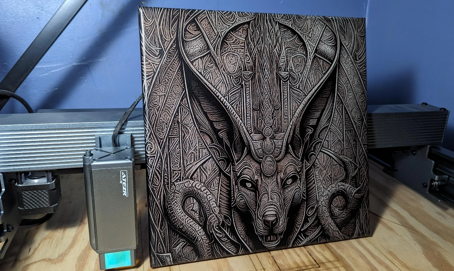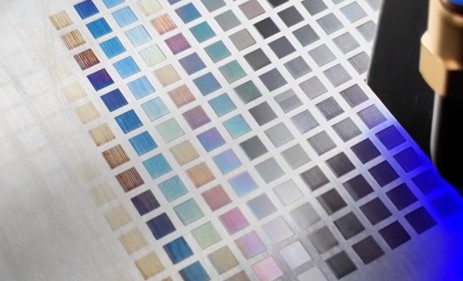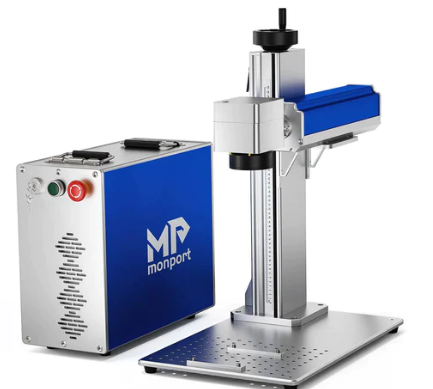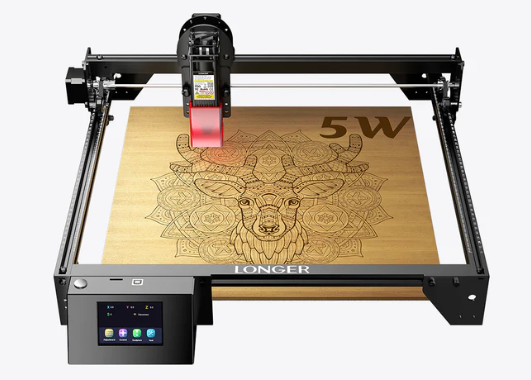Laser Engraver Types

What is Laser Engraving?
Laser engraving is a process that uses a focused beam of light to permanently mark, remove, or vaporize material from a surface. This creates a visible impression in the form of text, images, designs, or logos.
Here's a closer look at the process:
The Laser: A high-powered laser generates a focused beam of light.
Focusing the Beam: Lenses and mirrors direct and focus the beam onto the desired area or material.
Interaction with Material: The laser interacts with the material, either removing it through vaporization or causing a color change. One material that has many different color changes due to the level and speed of a laser is aluminum. Below is an example.

Result: A permanent, precise, and high-resolution mark is left on the surface.
Different types of laser engravers
Fiber Laser

Think of this laser as a high-powered F1 car. Blazing fast engraving and cutting, especially for metals. Imagine marking trophies in seconds!
Pros: Unmatched speed, exceptional metal engraving, compact size, low maintenance, long lifespan.
Cons: Expensive price tag, limited material compatibility (mostly metals and some plastics), safety concerns due to high power.
Diode Laser

This is the Swiss Army knife of laser engraving. Compact, portable, and budget-friendly, ideal for DIY enthusiasts and hobbyists.
Pros: Most affordable option, user-friendly software, decent material range (wood, leather, acrylic), easy setup.
Cons: Limited power (not for thick materials), slowest engraving speed, wider engravings with less detail, requires eye protection due to visible beam.
CO2 Laser

This laser is versatile and reliable, handles various materials well (wood, acrylic, fabric, leather, even some metals).
Pros: Good engraving depth for 3D effects, moderate price point, larger work areas available, wider material compatibility.
Cons: Slower than fiber lasers, requires regular maintenance (mirror cleaning), larger footprint, higher energy consumption.
Laser Engraver Comparison: Pros and Cons
Each type of laser has its own benefits and drawbacks. Below I will be going over the pros and cons for each type of laser engraver:
Fiber Laser Engraver:
Pros:
- Fastest engraving and cutting: Ideal for high-volume production.
- Excellent metal engraving: Works well on most metals, including reflective ones.
- Compact and energy-efficient: Requires less space and power than other options.
- Low maintenance: Solid-state design with no mirrors to adjust.
- Long lifespan: Can last for tens of thousands of hours.
Cons:
- Highest cost: Most expensive option, especially for high-power models.
- Limited material compatibility: Primarily for metals and some plastics.
- Safety concerns: High-powered laser requires additional safety precautions.
Diode Laser Engraver:
Pros:
- Most affordable option: Great for beginners and hobbyists.
- Compact and portable: Easy to set up and use anywhere.
- Wide range of materials: Can engrave wood, leather, acrylic, and some other materials.
- Easy to use: Software often simplified for DIY projects.
Cons:
- Lowest power: Not suitable for thick materials or deep engraving.
- Slowest engraving speed: Takes longer to complete projects.
- Limited laser focus: Can create wider engravings with less detail.
- Safety concerns: Requires eye protection due to visible laser beam.
CO2 Laser Engraver
Pros:
- Versatile material compatibility: Works with wood, acrylic, fabric, leather, rubber, and some metals.
- Good engraving depth: Can create deeper engravings for a 3D effect.
- Moderate price range: More affordable than fiber lasers but pricier than diodes.
- Large bed sizes available: Suitable for larger projects.
Cons:
- Slower than fiber lasers: Not ideal for high-speed production.
- Higher maintenance: Requires cleaning and aligning mirrors regularly.
- Larger footprint: Needs more space than diode lasers.
- Higher energy consumption: Less efficient than fiber lasers.
Main image from jc265 on reddit.
Related Articles
-
How to Laser Engrave Leather | Step-By-Step Guide
Can You Laser Engrave Leather?
How to Laser Engrave White Tiles Painted Black?
What Is The Best Low Cost Laser Engraver? My Opinion
How to Laser Engrave Acrylic with a Diode Laser: A Step-by-Step Guide
My Hands-On Review of the Monport 6-Watt Diode Laser Engraver
Laser Etching Glass
Laser Engraving A Photo | Full Guide
How Much Does Laser Engraving Cost
Is Laser Engraving Hard to Learn?
Why is laser engraving so expensive?
WHAT IS A LASER CUTTING MACHINE?
Top 7 Laser Engraving Business Ideas
10 Essential Safety Precautions for Home Laser Engraving Projects
Laser Engraving Cutting Boards | How To
Where To Buy Laser Cutting Materials?
Laser Engraving QR Codes
What Is DPI In Laser Engraving
How Much Is A Laser Engraving Machine